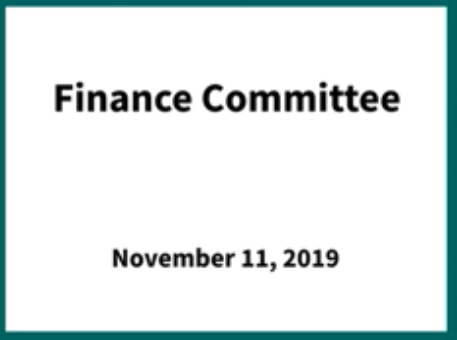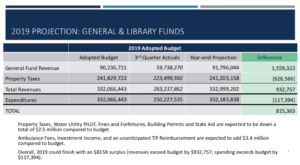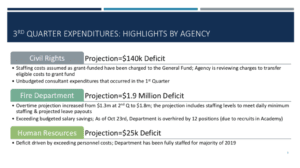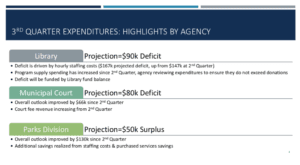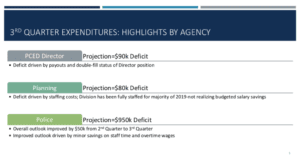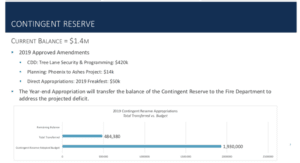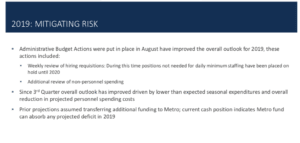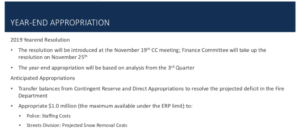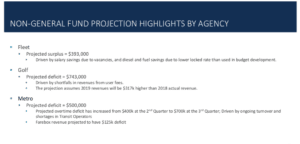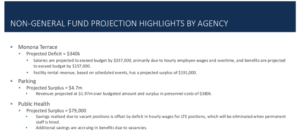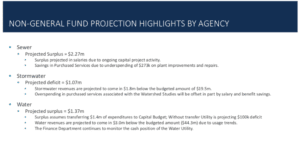Beyond the headlines. Housing Initiates job going away, city to negotiate removing concrete barriers blocking bike path, Judge Doyle Square discussion and 3rd Quarter Budget updates, which departments are going over their budget and why?
You can watch along here if you so desire.
GETTING STARTED
Mayor Satya Rhodes-Conway starts the meeting by wishing any veterans “within the sound of my voice” Happy Veterans Day and thank you for your service. They do the roll call.
Mayor separates items 14 & 15. Rebecca Kemble separates 8 and 11 for purposes of moving the substitute. Donna Moreland separates 2 & 4 “for clarification”. Kemble recuses herself from item 12. Bidar suggests they include 11 on the agenda clarifying that they are moving the substitute. Everything else on the agenda passes with the recommendations on the agenda.
REAL ESTATE SPECIALISTS/HOUSING INITIATIVES SPECIALIST
Moreland asks staff why #2 and #4 are so similar to each other. Matt Wachter says that #2 takes two staff members and moves them into that classification. #4 is an empty position which is his former position which has been empty and its taking it from an 18-10 to an 18-12. There will be three positions in this new Real Estate Development Specialist classification.
Moreland asks why the change from when he held the positions. Wachter says that the new classification in general is focused on real estate finance. So those two existing staff do that, his former position spent a lot of time doing project management, real estate finance on behalf of the city and it did a lot of the housing data piece and since that position has been empty for 2 years they have moved to more of a staff approach looking at housing data. In the new classification the individual will spend more time doing real estate projects and the data will be spread across the larger staff team.
Moreland says that since its been vacant the need is still there, greatly? Or no? Wachter says he still does some of the project management piece and a lot of projects just haven’t happened because the position has been vacant and the housing data and running the housing strategy committee has been done now by the new staff team.
Item #2 and 4 are both adopted on a voice vote, seemingly unanimous.
MULLINS BIKE PATH OBSTRUCTION
Mayor notes that Sue Springman from the Mullins Group is here in support and available to answer questions. There are no questions for her.
Kemble asks staff about the transportation corridor in general in that area. She says the city owns the transportation corridor but some time ago relinquished the right of way on the Washington Square property and that had been used as part of the bike boulevard for decades. They Mifflin Street bike boulevard and crossing over the river. A couple years ago Mullins put some concrete barriers there so it can no longer be used for that. She is wondering if in the negotiations they could, if its not too late, that is a key connector to keep pedestrians and bicyclists safe so they don’t have to walk on Johnson St. or E. Wash to cross the river. Can you ask them about removing those barriers in consideration of this other lease on the other property.
A staff person (sorry, listening to the audio, not video cuz of a downloading glitch) says Plan Commission asked a similar question and they just went through this morning so they haven’t gotten feedback from engineering yet. “Chris” joins them at the table and says that if that is something the committee or Plan Commission wants us to look at, we can try to do that, certainly that would take some time so if you want to refer it and bring forward this connection to the Mullins family they would be happy to do that.
Kemble asks when the current lease is up. They think its 2020. Kemble says there is time and they can wait a month. She moves to refer.
Item is referred.
JUDGE DOYLE SQUARE
#14 – Block 88 Negotiating Team Update
Negotiating update
No need to go into closed session. The negotiating team is asked to come up. There are three people there in support and available to answer questions: Helen Bradbury, Richard Arneson and Dwayne Johnson, all of Stonehouse Development. No questions of the registrants. (My blog on the details of the negotiations is here)
George Austin, the forever consultant for the city on Judge Doyle Square, says they have their final progress report. They are done with their negotiations after 10 negotiating sessions and 3 updates to and requests for direction from the Finance Committee. The report in legistar describes the key provisions of the development agreement. They also provided a draft resolution, the goal was to come with a final package for review and if it met with your acceptance or if there was additional tweaking to be done, that would be done in order to introduce a resolution on Nov 19, with a referral to the Finance Committee with consideration by the Finance Committee on November 25th and then the resolution authorizing the Affordable Housing Funds, which has already been introduced and action has been taken at the Community Development Block Grant committee and the two items would be here together and would go back to council on December 3.
Kevin Ramakrishna, from the City Attorney’s office, says he was intending to have the final development agreement to them for this meeting, he thinks they promised that, but they just finished up the last couple of terms that they were negotiating around 3:30 this afternoon, so they will be trading back a couple of drafts and that will be set. The last couple of things they had been discussion was security on the 15 year deferred payment. They will be getting that note tweaked a bit to have a “due on sale” provision in the event that the LLC sells the property before 15 years and they will be getting a corporate guarantee as additional security. The last piece is that on the land use restriction for the 80% units which are units we are not providing funding to, Stonehouse has agreed to give them 15 years as opposed to the 7 or 10 that WHEDA would be requiring. They are getting a little better than what WHEDA would have gotten. He says that there is a small thing about an indemnification agreement, that is not happening. That was with the previous architect but we don’t have to deal with that, we took care of it.
Austin says that they are looking for sponsors for the resolution.
Affordable Units Materially the same
Moreland asks about the language that Gephardt used that was a little concerning to her – it says “the affordable housing units will be disbursed throughout the apartment building and will be materially similar in quality of materials to the market rate units of the same size” and she wonders why they wouldn’t be the same materials. Austin says that they will be the same materials. Ramakrishna agrees. He says the one bedrooms will look like one bedrooms. Moreland says they are all the same whether they are 60%, 90%, 100%? They say yes and say “Rich is shaking his head” but whispers “I think I’m right”. Moreland says she wants to make sure its not granite in one and something else somewhere else. They say no.
Solar panels disappeared
Mayor asks about the solar, all of the original pictures had really nice pictures of solar panels and now there is a question mark as to whether there will be solar panels, why? Someone says that solar panels are not allowed above the Capital View height limit and they are having a technical engineering problem fitting them low enough and function. Mayor says they think that is not true, that you can’t exclude solar panels because of the Capital Height Limit. She says that bears some looking at, you might talk to Christie about that. Austin says they are working off of information from the Zoning Administration Office, they would be glad to review that. The developer has had a desire to install them and they would be installing conduit for their installation. They have been working under the assumption that might require a state law change to have those panels installed on the upper roof. If they can do that under existing state law, that would be all the better. The mayor says, “well, obviously, but I would just also note that, you know, don’t show us pictures of solar panels if its not actually legal to do them at the height of the building in the future, that’s not going to help anybody’s case” She says it is this committees expectation and the council expectation that we would see renewable energy in this project and to discover at the last minute that that’s not necessarily going to happen is . . .she understands the will is there, but it needs to be borne out.
Wrap Up
Mayor asks for other questions and asks if any committee members want to put their names on the resolution. Alders Kieth Furman and Mike Verveer (jokes he puts his name on whatever George drafts, going back decades) and Shiva Bidar say yes. Mayor says pending the resolution of the solar question she may add her name as well.
They thank the development team. She says a small amount of celebration will be allowed. They decide they will wait to celebrate in 2 weeks.
3rd QUARTER BUDGET PROJECTIONS
#15 – 2019 Budget: 3rd Quarter Projection Analysis
Here is a pdf of the presentation
Overview
Laura Larsen from Finance says they are projecting about an $815,000 surplus in the Library and General Funds. That surplus is primarily driven by strength on the revenue side. They are coming in over budget about $930,000. That is driven primarily by ambulance fees, investment income and unanticipated TIF reimbursement. Those revenues are offsetting projected expenditure deficit of $117,000. When they were there for second quarter, they were projecting an expenditure deficit of about $800,000. That was primarily due to the assumption they would have to increase the general fund subsidy to Metro. Metro is still projecting to be over budget but they don’t think they will need additional general fund support to cover the deficit but can cover it with their fund.
By Agency
When they break down the budgets in more detail.
Civil Rights Department has been projecting a deficit through all of 2019. They are currently projecting they will end the year $140,000 over budget. Part of that is driven by staffing costs that were assumed to be charged to a grant, they have been charged to the general fund. They are currently reviewing their time transactions to determine what portion can be transferred to the grant before year end. A portion of this is also driven by unbudgeted consultant expenditures that were incurred early in 2019.
Fire Department is projecting a deficit of $1.9M. This is primarily driven by overtime expenditures and is offset by exceeding budgeted salary savings. The outlook on Fire Department overtime got worse from 2nd to 3rd quarter. At 2nd quarter they were projecting a $1.3M deficit and at the close of the 3rd quarter they are projecting a $1.8M deficit. That is a projection of what the department thinks it needs to meet its daily staffing requirements and projected leave payouts for sworn staff that would hit in the 4th quarter
Human Resources – The HR department is projecting a $25,000 surplus [sic – actually a deficit], primarily driven by the fact that the department has been staffed the entire year with very little turnover, so they are not meeting their budgeted salary savings. (She said suplus, but described a deficit and the slide says deficit)
Library – They are projecting a $90,000 deficit primarily driven by hourly staffing costs. At the 3rd quarter they are projecting a $167,000 deficit on hourly costs, up form $150,000 at the second quarter. The other item they are closely monitoring is the supply expenditures, specifically program supplies, much of that budget is funded by donations through the Library Foundation and they are working with them to make sure what is expended does not exceed what is actually realized in terms of donations. This deficit will be funded by the Library Fund balance, not the general fund.
Municipal Court – They are projecting an $80,000 deficit. That has improved since the second quarter and they are seeing the court revenue rebound a little bit. That is something they have continually seen the revenue falling off more and more, this is a positive change in that trend.
Parks – They are projecting a $50,000 surplus. They had been projecting a deficit, but the outlook has improved by $130,000 since the second quarter driven by the final numbers of the seasonal staffing and the revenue the parks division realizes in the second quarter. Most of the surplus is from vacant positions, savings in hourly spending and purchase of services lines (water and program services)
PCED Office of Director – $90,000 deficit. This is driven by leave payout for previous director and the fact that the Director spot has been double filled for a portion of the year.
Planning Division – $80,000 deficit. They had seen a lot of turnover in the last few years but hasn’t seen much this year so they are exceeding their budget in salary savings.
Police Department – They are projecting a $950,000 deficit. This is an improved outlook from the second quarter of $50,000 (that’s what she said). She says this is driven by overtime improving. The projecting for overtime funding is down $14,000 from the second quarter. They are also exceeding their salary savings, they have had additional resignations and retirements since they did the second quarter review.
Streets – They anticipated there would be questions about snow, the Streets Division is projecting a $1M deficit by year end that is driven by snow costs and what we are projecting between now and the end of the year for winter weather, but also a trend they have been seeing for a couple of years now which is declining recycling revenues. The chart shows snowfall going back to 2016 by quarter. After today’s event we will have exceeded the total 4th quarter snowfall in 2018 and much closer to being on track with the snowfall totals in 2016. They are monitoring the weather and what is projected. They are assuming 4 more major snow events in the 4th quarter and that is what is driving the $1M deficit number
Contingent Reserve
It currently has a balance of $1.4M. This body has approved three amendment to take funding out of the contingent reserve. Two amendments were for the Community Development Division for the Tree Lane Property, totaling $420,000 and there was an amendment to appropriate funds that had fallen to fund balance in the planning division for the Phoenix to Ashes project and funds for the city share of the 2019 Freakfest event. In total those items are about $480,000 leaving them with $1.4 to transfer to resolve to a number of the agency deficits. Coming out of the second quarter
Mitigating Risk
After 2nd quarter projections in August they had put a number of administrative actions in place to ensure that the city was able to finish 2019 within budget. Those actions have been a closer review and monitoring of positions, specifically holding off on positions that aren’t required to meet daily minimum staffing levels and an additional review of non-personnel spending. The good news is that since the 3rd quarter the overall outlook has improved. They saw strength in some of their seasonal expenditures and in the 3rd quarter in the Public Works Division time gets charged to capital projects because it is one of the busiest quarters in terms of capital activity. Specifically in Engineering they saw the time charged to the capital projects was stronger than what they had been projecting. The other items that is a big piece of the improved outlook from the second quarter is Metro. They had assumed they would have to give them additional funding by year end and they believe Metro will be able to fund that in their fund balance.
Year End Resolution
At their meeting in two weeks they will have the year end resolution where they will bring forward a series of adjustments to the budget to adjust the deficits. Under the state Expenditure Restraint Program they can appropriate approximately $1M. So they will be recommending $1M of appropriations to cover these deficits. They will also be looking at appropriating the funding they received from FEMA for the flood response, to help with the 2019 situation. They will also transfer the full balance of the contingent reserve and items budgeted centrally and direct appropriations out to agency budgets.
Non-General Fund Items
Fleet – surplus of $393,000 driven by salary savings as well as savings on diesel and fuel and they have been fortunate that the locked in rates for diesel and fuel have been lower than what was assumed in the budget.
Golf Enterprise – $743,000 deficit. The projection does pick up the last piece of the season. The revenues in 2019 are $317,000 higher than 2018 actual, but they continue to see that structural deficit where the expenditures exceed what they realize on an annual basis in terms of revenue.
Metro – $500,000 deficit. One thing that they looking at closely is their overtime. At the second quarter they were projecting that they would be over by about $400,000 which is consistent with where it has been the past 3-4 years but from the 2nd to 3rd quarter the overtime deficit has grown to $700,000 driven by ongoing turn over and overall shortage in transit operators. They are also continuing to see a shortfall from the projected revenue from the fairbox. Based on the monthly averages, they will be about $125,000 short on fair box revenue.
Monona Terrace is projecting a deficit of $340,000. This is driven by hourly staffing which is something that is event driven and based on their bookings. They did increase their hourly budget in 2020 to get more in line with what they were seeing in 2019.
Parking Division – $4.7M surplus. Revenues are projected to be over just shy of $2M.
Public Health – $79,000 surplus. That assumes using the full amount of fund balance built into the 2019 budget. One item they continue to monitor is their use of LTE and hourly positions to help them while they had a number of vacant positions. As they get more permanent staff they will have to closely monitor their hourly expenditures to make sure they are scaling back on the hourly side.
Sewer – Surplus of about $2.3M. Their purchase of services spending is projected to come in under budget.
Stormwater should have been shown as a surplus, they have a budgeted contingent reserve of about $1M and so this assumes they would have to use their full contingent reserve in this last part of the year, which I think is unlikely at this point so they should end the year pretty close to budget.
Water Utility – about a $1.3M surplus. She says this $1.3M does assume that in the year end appropriation this body and the full council would approve transferring $1.4M in the expenditures in the water utility budget to the capital budget. If that is not approved then the water utility would be projecting about a $100,000 deficit. One of the biggest issues in the water utility is that all year they have been seeing the metered revenue come down and they were about 3% under budget, but after the 3rd quarter that had actually fallen to 6.5% below budget so utilization is falling down which is having a significant impact on the metered revenue. That is about a $3M impact on the operations of the water Utility. They continue to work with the water utility to closely monitor their cash position.
Questions
Keith Furman asks about the snow projections. He isn’t sure they won’t have that little snow and he’s wondering how they deal with that. Larson says that the first two events the roads were really warm so they were not full plows. $1M was before today’s event. Their plan is to put every dollar of surplus to the streets division budget knowing that with the outlook on the temperatures every drop of precipitation we get is going to be snow and what we have been fortunate with in the past, is when they got precipitation it came as rain, which won’t be the case this year.
Mayor says “we haven’t done any full plows yet, right” Charlie Romines from the Streets Division says they have not done a general plow yet, just salt route runs and sanding neighborhoods. Mayor asks how today is looking. He says they are getting there and they are much better this afternoon than they were this morning. They were doing sanding in the neighborhoods this afternoon and hitting the newly expanded CSCL (Clean Streets, Clean Lakes) areas for Tuesdays and Wednesdays tomorrow and Wednesday in anticipation of the next snow event which is Wednesday afternoon where they are forecasting one to three more inches. Highly irregular.
Furman asks about the leaf pick up. Romines says they picked up 1,580 tons of leaves this weekend. He gives a shout out to the streets crew that went full on this weekend, 11 hours Saturday, 11 hours Sunday, full crews, 26 leaf crews out, they had semi trailers out hauling for the first time, they had street sweeping from 7am on Sat until 5pm on Sun. And at 1am they were doing snow. A big shout out to the streets crews and supervisors that bore the brunt of that? Furman asks if there were budget impacts related to that. Romines says that the leaves are mitigated by the stormwater utility and a lot of it was taking shifts that they lost. Snow arrived at the same time as peak leaves season arrived. They are trying to do leaves and fight through 16 inches of snow at the same time and while much of the snow has melted, its not melting off the leaf piles and it just makes everything harder to see, harder to get at, smaller to work with. But the leaf overtime has helped. A lot of it is taking overtime they would have worked and shifts they lost to doing snow and jamming it in on Saturday and Sunday with the look forward to this week of a lost week to any meaningful leaf collection and no street sweeping, they were trying to hit that window. They aren’t going to mess any of Laura’s projections up at this point. They are hoping next week they can do leaves again.
Moreland asks how snow is trending and explain the reserves. Larsen says that goal is to maintain an unassigned fund balance of 15% and the contingent reserve is assumed to be at .5% of budgeted expenditures. Moreland asks given the deficits how much are we looking at having to apply. Larsen says that if the projections hold, in the year-end appropriation they will be appropriating this $800,000 and a little bit of the unassigned fund balance which would mean that they would not contribute anything to to unassigned fund balance at the end of 2019. Moreland asks if that wouldn’t be touched. Larsen says they will have to appropriate about $185,000 from the unassigned fund balance. Mayor adds that they won’t be adding to it. Dave Schmiedicke, the Finance Director says these are always projections, Laura and her team have been conservative in the projections so usually they tend to come in below what we are projecting. There is probably a good chance we will add slightly to the reserves at year end. A lot of it depends upon what happens with the weather. They have often appropriated everything they have to the streets budget in the year end appropriation and then the snow doesn’t materialize.
Moreland asks about the staff savings. Is that a line item in every budget. Larsen says agency budgets have a salary savings line and for the most part it is 1-2%. Moreland asks how that works out at the end of the year. Larsen says in general the city doesn’t hold a high number of vacant positions. Our vacancy rate is usually around 4%. Which out of 3,000 employees is really not that many vacant positions. Typically when agencies have a vacant position it is generally filled throughout the year. They see issues with agencies hitting their salary savings amounts when there are smaller agencies and don’t have a lot of turnover. Planning and HR have a smaller number of FTEs but they have seen a lot of retirement and have hired and now it is stabilizing and they aren’t seeing the turnover they used to see. The other thing that is complicated is that some is applied to capital projects or grants and if they aren’t realizing that, then the excess staff costs turn to the general fund.
Mike Verveer asks about revenues – in surplus and deficit, which are most substantive. What is driving the negative outlook, is it building permits. Schmiedicke says that building permits are down half a million, the property tax number is down about $600,000. Water Utility PILOT (payment in lieu of taxes) will be down about $250,000. Some of it is that they are not adding as much capital to their base, but the PFC decision that disallows certain costs also affects the PILOT payment cuz it reduces the overall base upon which the mill rate is applies. Fines and forfeitures has been week throughout the year again, about half a million dollars and state aid from Payment for Municipal Services (PMS) that came in $600,000 lower than what was projected in the budget. On the positive side ambulance fees have been trending higher, stronger than the 2nd quarter projection. Investment income has been slightly stronger and the TIF reimbursement which they did not anticipate was due to the sale of a property in the Wingra TID and that brought in $1.9M, so that is offsetting a lot of the other areas. Much of these areas of lower revenues they tried to address in the 2020 budget with those forecasts.
Verveer asks Norm Davis about the grant that Civil Rights didn’t bill, is that the regular EEOC grant they have received for decades? Yes. How is this year different than prior years? Davis says they budgeted for half of the paralegal mediator position to be funded by the grant. When they got into the year they were attributing the salary to the general fund and now they are working on reclassifying those dollars back to the grant. Verveer asks if they still think the deficit will be that substantial. Verveer says when they talked about the consultant that was a relatively small amount of money. Larsen says the number assumes that they won’t be able to transfer any of the costs, its the most conservative. She says the other thing they have been reviewing is the Language Access Program, there is a significant amount of funding that is encumbered and they are working with city staff to see how much will be 2019 and how much will be 2020. Larsen says the deficit here is conservative but if things don’t break our way this is the number. Verveer asks if they will be able to budget accordingly for the EEOC grant in the future so this doesn’t happen. Davis says they will make sure that the charges are appropriate. He says they also looked at the ASPIRE funding that has hourly funding that ends in August, they were able to look at how to reduce that calculation. Davis is quite confident it won’t be $140,000.
Verveer says they covered Fire and Police and Metro overtime concerns on the operating budget a few weeks ago so he won’t ask now.
Verveer asks about fund balances. Do we know what the ballpark Library Fund Balance is – off mic Betsy says $700,00 that is repeated by Verveer. Larsen says in recent years they have maintained and unassigned balance and they believe that they can cover that. Also, the hourly costs were re-base lined in the 2020 budget, especially with the new Pinney Library coming on they worked to analyze what is the true baseline of the hourly expenditures. Especially since the $15 minimum wage is implemented now and they have one of the biggest cohorts of the general staff. They don’t think they will find these deficits in 2020. Verveer says they worked really hard to address these issues, especially Police and Fire in the operating budget.
Verveer asks what the Metro Transit fund balance is? Larsen doesn’t know, they were looking at their cash position and projecting the whole $14M plus general fund subsidy they are looking to get and based on those numbers they were going to be in a positive cash position, but she can get them the unassigned fund balance at the end of 2018.
Verveer asks about the Monona Terrace fund balance. He asks what their reserve fund balance is. Schmidicke says its is around 10% of their revenues, so if he remembers right is it around $1M. Verveer asks in the Monona Terrace Fund will cover the projected deficit.
Verveer asks about the Year End Appropriation, he asks about the FEMA reimbursement, is that the final reimbursement or are we still working with the federal government on August 20 issues from 2018. Larsen says it is the final reimbursement. She says the way the final amount was dispersed the $300,000 would be the general fund share of the reimbursement from that event. She thinks it was $600,000 total. The remaining $300,000 was split, a big piece wen to the Stormwater enterprise and the final share went to reimburse some of the capital costs. Verveer asks about Monona Terrace submissions for expenditures, how does the reimbursement for that enterprise work? Larsen says she would have to look, Kathy Cryan did a good job coordinating the city response and putting the full package of materials together and went through a painstaking process with the federal government to determine which of the expenditures we reporter were eligible for reimbursement. A lot of the expenditures we submitted were not eligible. She would have to go back and look to see fitly could get reimbursed for the Monona Terrace items.
Verveer asks about the last slide and if the Sewer Utility also had lower meter revenue. The billings of the sewer utility are based on water usage. Has that also been an issue for them. Larsen says that engineering re-sets those rates in April and they are not seeing anything like the water utility where their revenues are down by 6.5%. They are projecting almost 98% of their metered revenue. Verveer asks if that is because they are at the table every year with annual increases where they true up their experiences.
Moreland moves to adjourn.

